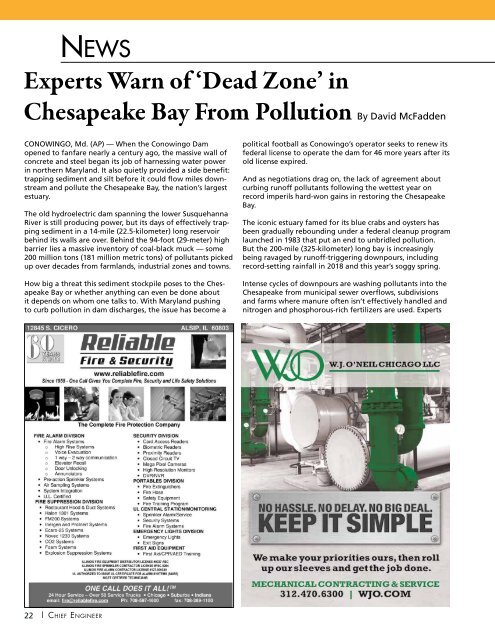CEAC-2019-08-August
Create successful ePaper yourself
Turn your PDF publications into a flip-book with our unique Google optimized e-Paper software.
NEWS<br />
Experts Warn of ‘Dead Zone’ in<br />
Chesapeake Bay From Pollution By David McFadden<br />
CONOWINGO, Md. (AP) — When the Conowingo Dam<br />
opened to fanfare nearly a century ago, the massive wall of<br />
concrete and steel began its job of harnessing water power<br />
in northern Maryland. It also quietly provided a side benefit:<br />
trapping sediment and silt before it could flow miles downstream<br />
and pollute the Chesapeake Bay, the nation’s largest<br />
estuary.<br />
The old hydroelectric dam spanning the lower Susquehanna<br />
River is still producing power, but its days of effectively trapping<br />
sediment in a 14-mile (22.5-kilometer) long reservoir<br />
behind its walls are over. Behind the 94-foot (29-meter) high<br />
barrier lies a massive inventory of coal-black muck — some<br />
200 million tons (181 million metric tons) of pollutants picked<br />
up over decades from farmlands, industrial zones and towns.<br />
How big a threat this sediment stockpile poses to the Chesapeake<br />
Bay or whether anything can even be done about<br />
it depends on whom one talks to. With Maryland pushing<br />
to curb pollution in dam discharges, the issue has become a<br />
political football as Conowingo’s operator seeks to renew its<br />
federal license to operate the dam for 46 more years after its<br />
old license expired.<br />
And as negotiations drag on, the lack of agreement about<br />
curbing runoff pollutants following the wettest year on<br />
record imperils hard-won gains in restoring the Chesapeake<br />
Bay.<br />
The iconic estuary famed for its blue crabs and oysters has<br />
been gradually rebounding under a federal cleanup program<br />
launched in 1983 that put an end to unbridled pollution.<br />
But the 200-mile (325-kilometer) long bay is increasingly<br />
being ravaged by runoff-triggering downpours, including<br />
record-setting rainfall in 2018 and this year’s soggy spring.<br />
Intense cycles of downpours are washing pollutants into the<br />
Chesapeake from municipal sewer overflows, subdivisions<br />
and farms where manure often isn’t effectively handled and<br />
nitrogen and phosphorous-rich fertilizers are used. Experts<br />
Water flows through Conowingo Dam, a hydroelectric dam spanning the lower Susquehanna River near Conowingo, Md., on Thursday, May 16, <strong>2019</strong>.<br />
Officials once counted on the dam to block large amounts of sediment in the Susquehanna from reaching Chesapeake Bay, the nation’s largest estuary,<br />
but the reservoir behind the dam has filled with sediment far sooner than expected. (AP Photo/Steve Ruark)<br />
say climate change is accelerating the environmental decline,<br />
potentially leading to more damaging algae blooms and<br />
dead zones in the Chesapeake and coastal waters.<br />
Maryland politicians and watermen who make their living<br />
off the bay’s fragile bounty portray the sediment stored<br />
behind the Conowingo as an existential threat, asserting the<br />
massive deposit of reservoir muck would devastate the bay<br />
if ever released downstream in a major storm. They note<br />
that sediment freely flows over the dam during downpours,<br />
turning the upper bay’s waters a murky brown.<br />
“The situation behind the dam is a ticking time bomb,” said<br />
Genevieve Croker, spokeswoman for the Clean Chesapeake<br />
Coalition, a grouping of rural Maryland countiesáthat have<br />
Republican Gov. Larry Hogan’s ear.<br />
Qian Zhang, an assistant research scientist at the University<br />
of Maryland Center for Environmental Science, confirms that<br />
the sediment does flow freely.<br />
“The reservoir is no longer capable of trapping sediment<br />
and sediment-associated nutrients. It will release sediment<br />
during storm events, creating room for sediment to deposit<br />
in subsequent days. However, from a long-term mass-balance<br />
perspective, the reservoir is essentially at a stage where<br />
(Continued on page 24)<br />
sediments entering the reservoir equal sediments leaving,”<br />
Zhang said.<br />
But he and numerous other bay-area scientists say nutrient<br />
pollution, not sediment, is the major threat, noting that<br />
most of the pollutants flowing into the Chesapeake come<br />
from upstream, particularly in Pennsylvania. Most of the nitrogen<br />
pollutants reaching the bay, for instance, travel there<br />
as dissolved nitrate and are not affected at all by the Conowingo’s<br />
sediment storage. They say mitigating the impacts<br />
from the huge infill behind the Maryland dam is part of<br />
the puzzle but hardly the keystone piece in the restoration<br />
strategy.<br />
INSULATION CONTRACTOR<br />
FALLS MECHANICAL<br />
INSULATION, INC.<br />
SPECIALIZING IN INSULATION OF PLUMBING,<br />
HEATING, AND COOLING SYSTEMS<br />
50 YEARS OF QUALITY SERVICE<br />
WITH LOCAL 17 HEAT & FROST INSULATORS<br />
7703 W. 99th Street • Hickory Hills, IL 60457<br />
7<strong>08</strong>.599.4700 • Fax 7<strong>08</strong>.599.4769<br />
Email: fallinsulation@sbcglobal.net<br />
22 | Chief Engineer<br />
Volume 84 · Number 8 | 23


















